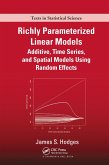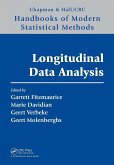Generalized Linear Mixed Models: Modern Concepts, Methods, and Applications (2nd edition) presents an updated introduction to linear modeling using the generalized linear mixed model (GLMM) as the overarching conceptual framework. For students new to statistical modeling, this book helps them see the big picture - linear modeling as broadly understood and its intimate connection with statistical design and mathematical statistics. For readers experienced in statistical practice, but new to GLMMs, the book provides a comprehensive introduction to GLMM methodology and its underlying theory.
Unlike textbooks that focus on classical linear models or generalized linear models or mixed models, this book covers all of the above as members of a unified GLMM family of linear models. In addition to essential theory and methodology, this book features a rich collection of examples using SAS® software to illustrate GLMM practice. This second edition is updated to reflect lessons learned and experience gained regarding best practices and modeling choices faced by GLMM practitioners. New to this edition are two chapters focusing on Bayesian methods for GLMMs.
Key Features:
- Most statistical modeling books cover classical linear models or advanced generalized and mixed models; this book covers all members of the GLMM family - classical and advanced models.
- Incorporates lessons learned from experience and on-going research to provide up-to-date examples of best practices.
- Illustrates connections between statistical design and modeling: guidelines for translating study design into appropriate model and in-depth illustrations of how to implement these guidelines; use of GLMM methods to improve planning and design.
- Discusses the difference between marginal and conditional models, differences in the inference space they are intended to address and when each type of model is appropriate.
- In addition to likelihood-based frequentist estimation and inference, provides a brief introduction to Bayesian methods for GLMMs.
Walt Stroup is an Emeritus Professor of Statistics. He served on the University of Nebraska statistics faculty for over 40 years, specializing in statistical modeling and statistical design. He is a Fellow of the American Statistical Association, winner of the University of Nebraska Outstanding Teaching and Innovative Curriculum Award and author or co-author of three books on mixed models and their extensions.
Marina Ptukhina (Pa-too-he-nuh), PhD, is an Associate Professor of Statistics at Whitman College. She is interested in statistical modeling, design and analysis of research studies and their applications. Her research includes applications of statistics to economics, biostatistics and statistical education. Ptukhina earned a PhD in Statistics from the University of Nebraska-Lincoln, a Master of Science degree in Mathematics from Texas Tech University and a Specialist degree in Management from The National Technical University "Kharkiv Polytechnic Institute."
Julie Garai, PhD, is a Data Scientist at Loop. She earned her PhD in Statistics from the University of Nebraska-Lincoln and a bachelor's degree in Mathematics and Spanish from Doane College. Dr Garai actively collaborates with statisticians, psychologists, ecologists, forest scientists, software engineers, and business leaders in academia and industry. In her spare time, she enjoys leisurely walks with her dogs, dance parties with her children, and playing the trombone.
Unlike textbooks that focus on classical linear models or generalized linear models or mixed models, this book covers all of the above as members of a unified GLMM family of linear models. In addition to essential theory and methodology, this book features a rich collection of examples using SAS® software to illustrate GLMM practice. This second edition is updated to reflect lessons learned and experience gained regarding best practices and modeling choices faced by GLMM practitioners. New to this edition are two chapters focusing on Bayesian methods for GLMMs.
Key Features:
- Most statistical modeling books cover classical linear models or advanced generalized and mixed models; this book covers all members of the GLMM family - classical and advanced models.
- Incorporates lessons learned from experience and on-going research to provide up-to-date examples of best practices.
- Illustrates connections between statistical design and modeling: guidelines for translating study design into appropriate model and in-depth illustrations of how to implement these guidelines; use of GLMM methods to improve planning and design.
- Discusses the difference between marginal and conditional models, differences in the inference space they are intended to address and when each type of model is appropriate.
- In addition to likelihood-based frequentist estimation and inference, provides a brief introduction to Bayesian methods for GLMMs.
Walt Stroup is an Emeritus Professor of Statistics. He served on the University of Nebraska statistics faculty for over 40 years, specializing in statistical modeling and statistical design. He is a Fellow of the American Statistical Association, winner of the University of Nebraska Outstanding Teaching and Innovative Curriculum Award and author or co-author of three books on mixed models and their extensions.
Marina Ptukhina (Pa-too-he-nuh), PhD, is an Associate Professor of Statistics at Whitman College. She is interested in statistical modeling, design and analysis of research studies and their applications. Her research includes applications of statistics to economics, biostatistics and statistical education. Ptukhina earned a PhD in Statistics from the University of Nebraska-Lincoln, a Master of Science degree in Mathematics from Texas Tech University and a Specialist degree in Management from The National Technical University "Kharkiv Polytechnic Institute."
Julie Garai, PhD, is a Data Scientist at Loop. She earned her PhD in Statistics from the University of Nebraska-Lincoln and a bachelor's degree in Mathematics and Spanish from Doane College. Dr Garai actively collaborates with statisticians, psychologists, ecologists, forest scientists, software engineers, and business leaders in academia and industry. In her spare time, she enjoys leisurely walks with her dogs, dance parties with her children, and playing the trombone.








